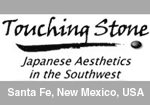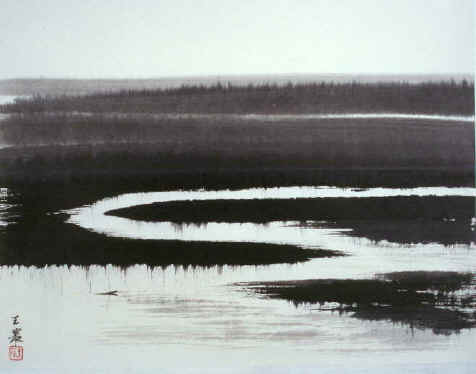
presents
Between Heaven and Earth
Contemporary sumi-e by Wang Nong
June 29 - Aug 29, 2001

Sumi-e, a traditional Chinese and Japanese art form, literally means painting with water and ink. The term often conjures up images of black-and-white paintings of oriental scenery - misty mountains with crooked pines and cascading waterfalls. In fact, contemporary sumi-e (Sui Boku-ga) is an extraordinarily expressive medium especially effective for capturing subtle moods of quiet subjects with the sparest of forms and colors. In color sumi-e (Bokusai-ga), color is used to enhance otherwise monochromatic scenes. Unlike realistic Western painting which uses light and shadows to create perspectives, sumi-e emphasizes beauty of forms created by movement of the brush and flow and spread of the ink on paper. In this regard, sumi-e and calligraphy shares common aesthetic quality that has no parallel in Western art.
The exhibition - Click on images to view, price provided by request. Tel/Fax (505) 988-8072, see Inquiry/Order.
About the artist
To those accustomed to traditional Chinese sumi-e, Wang Nong’s sumi-e paintings are a revelation. "Packing power of a storm and sensitivity of a rainbow", Wang Nong’s sumie paintings have won him recognition as one of the foremost contemporary Chinese artists of this generation. His trademark compositions of stark landscapes set off by touches of bold colors echo the contradictions that mark the artist’s life.
Born in Beijing in 1953 as the second son of a respected Chinese philosopher Professor Wang Sen-Ran, Wang Nong aspired to an artist career since early childhood. By a horrible twist of fate, his dream almost never came true.
In 1969, when Wang Nong was 16, China fell into the vise grip of the Cultural Revolution. Perceived as one of the privileged, Wang was sent to a labor camp in the remote Heilongjiang (Black Dragon River) district near the Russian border, known as the "Northern Vast Wilderness". It was a place of extraordinary beauty as well as inhospitality. Wang endured six long years of hard labor there, where winter temperature regularly fell below minus 35 degree Celsius. By the time Wang returned to Beijing in 1975, he learned that his peers from working class families were not only spared the labor camp experience and many had finished university. He felt a great sense of loss, not only for himself, but an entire generation of promising talents.
To find emotional retribution, he turned again to painting. His bold forceful brush strokes turned memories of the Northern Vast Wilderness into startlingly beautiful landscapes. In his recently published Wang Nong’s Album of Paintings, he wrote, "I often find myself painting rain and snow scenes, perhaps because I spent a good part of my youth in rain and snow. The stark beauty of the Northern Vast Wilderness has become an indelible part of my memories. As if to compensate for the wounds and loss of my generation, I paint to seek balance and consolation". To this date, Wang continues to paint from memory. When he travels, he rarely makes sketches. Instead, he would mentally record the journey. Upon returning from a trip, he would immerse himself in painting, working quickly and intensely from what he sees in his mind. Wang’s landscape paintings are not mere reproduction of static scenery, but an intimate communion with the heart of the artist.
Wang Nong’s distinctive style of sumie soon attracted attentions in China. His big break came in 1987, when he was invited to exhibit at the Rijks Museum in Amsterdam, Holland. One of Wang’s paintings from the exhibition was acquired as permanent collection by the museum. Soon afterward, Wang had the honor to be the first Chinese artist invited to work in Japan under a new cultural exchange program. Wang’s unique style of sumie gained immediate recognition in Japan, where he received an award in the Japan National Premier Sumie Painting Exhibition in 1987. A year later, Wang finally fulfilled his dream and entered a graduate program in Tokyo Metropolitan University. After finishing the program, he stayed in Japan and joined the National Chiba University as a visiting scholar. In the ensuing years, Wang exhibited widely and became one of the most sought after contemporary sumie artists in Japan.
Despite his popularity and success, Wang maintains a simple life-style and devotes his energy single-mindedly to teaching and making art. Speaking recently in his modest one-room apartment in Tokyo, Wang explained his working principle, "A true artist paints with his heart. What he paints may never be appreciated or understood, or may even be misunderstood. But what he paints is the truth and truth is eternal. Some artists paint what the audience likes to see, rather than from their hearts. Those works may achieve temporary success, but they are a pretense that cannot withstand the test of time. More and more, today’s audience understands the difference and appreciates the value of true art."
Asked how he could turn a horrific experience into such beautiful art, Wang said, "Years ago, I had a dream. I wanted to capture the beauty of nature and longing of my generation for a better life and distill them into something beautiful, and offer it to my own generation that has lost so much. If I could do that, perhaps I have contributed my small share to this generation." Judging from the responses to his works, Wang may have accomplished far more than he realizes.
Selected Exhibitions (from over 100 in career)
1987 Rijks Museum, Amsterdam, Holland
1989 Gallery Ginza Salon, Ginza, Tokyo
1990 Gallery Tochi, Ginza, Tokyo
1990 Daimaru & Sogo Department Store, Osaka
1990 Sogo Department Store, Nara
1991 Gallery Tochi, Ginza, Tokyo
1992 Tohbu Department Store, Tokyo
1992 Lecture and Exhibition, Nobeoka
1993 Japan-China Friendship Museum, Tokyo
1993 Ozu Washi Museum, Tokyo
1994 Ozu Washi Museum, Tokyo
1995 Ozu Washi Museum, Tokyo
1996 Kyobashi Art Museum, Tokyo
1996 General Culture Center, Nobeoka
1997 Gallery Himawari, Ginza, Tokyo
1998 Izukohgen Museum, Shizuoka
1998 Keioh Plaza Hotel, Shinjuku, Tokyo
Publication
Wang Nong’s Album of Paintings. 1998. Shanghai Fine Art Publisher.